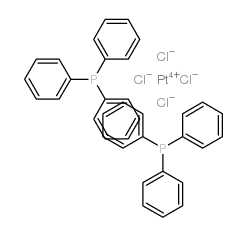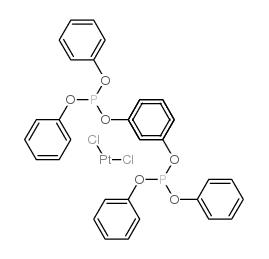14873-63-3
| Name | Dichlorobis(benzonitrile)platinum(II) |
|---|---|
| Synonyms |
EINECS 238-943-7
Benzonitrile, platinum(2+) salt, hydrochloride (2:1:2) Bis(benzonitrile)dichloroplatinum(II) Platinum(2+) chloride - benzonitrile (1:2:2) Platinum(2+)ato chlorido - benzonitrilato (1:2:2) MFCD00013125 |
| Boiling Point | 191.1ºC at 760mmHg |
|---|---|
| Melting Point | 224ºC (dec.) |
| Molecular Formula | C14H10Cl2N2Pt |
| Molecular Weight | 472.233 |
| Flash Point | 71.7ºC |
| Exact Mass | 470.986908 |
| PSA | 47.58000 |
| Vapour Pressure | 0.524mmHg at 25°C |
|
Section 1: Product Identification Chemical Name:Dichlorobis(benzonitrile)platinum (II), 99% CAS Registry Number:14873-63-3 Formula:PtCl2(C6H5CN)2 EINECS Number:238-943-7 Chemical Family:organometallic complexes Synonym:Platinum dichlorobis(benzonitrile)
Section 2: Composition and Information on Ingredients IngredientCAS NumberPercentACGIH (TWA)OSHA (PEL) Title Compound14873-63-3100%1mg/m3(as-Pt)no data Section 3: Hazards Identification Emergency Overview:Irritating to the respiratory tract, skin and eyes. May be harmful if swallowed. Primary Routes of Exposure:Ingestion, inhalation, skin Eye Contact:Causes mild to moderate irritation of the eyes. Skin Contact:Causes slight to mild irritation of the skin. Inhalation:Irritating to skin, eyes and respiratory tract. Ingestion:Ingestion may lead to dizziness, abdominal cramps, vomiting, bloody diarrhea, weakness, and convulsions. Acute Health Affects:Irritating to skin, eyes, mucous membranes, and respiratory tract. Chronic Health Affects:No information available on long-term chronic effects. NTP:No IARC:No OSHA:No SECTION 4: First Aid Measures Immediately flush the eyes with copious amounts of water for at least 10-15 minutes. A victim may need Eye Exposure: assistance in keeping their eye lids open. Get immediate medical attention. Wash the affected area with water. Remove contaminated clothes if necessary. Seek medical assistance if Skin Exposure: irritation persists. Remove the victim to fresh air. Closely monitor the victim for signs of respiratory problems, such as difficulty Inhalation: in breathing, coughing, wheezing, or pain. In such cases seek immediate medical assistance. Seek medical attention immediately. Keep the victim calm. Give the victim water (only if conscious). Induce Ingestion: vomiting only if directed by medical personnel. SECTION 5: Fire Fighting Measures Flash Point:not applicable Autoignition Temperature:none Explosion Limits:none Extinguishing Medium:carbon dioxide, foam or dry powder If this product is involved in a fire, fire fighters should be equipped with a NIOSH approved positive pressure Special Fire Fighting Procedures: self- contained breathing apparatus and full protective clothing. Hazardous Combustion andIf involved in a fire this material may emit toxic and corrosive fumes. Decomposion Products: Unusual Fire or Explosion Hazards: No unusual fire or explosion hazards. SECTION 6: Accidental Release Measures Small spills can be mixed with vermiculite, sodium carbonate or other suitable non combustible adsorbent and Spill and Leak Procedures: swept up. SECTION 7: Handling and Storage Handling and Storage:Store in a cool, dry place in a tightly sealed container. SECTION 8: Exposure Controls and Personal Protection Eye Protection:Always wear approved safety glasses when handling a chemical substance in the laboratory. Skin Protection:Wear protective clothing and gloves. Ventilation:To minimize exposure, handle the material in an efficient fume hood. If ventilation is not available a respirator should be worn. The use of respirators requires a Respirator Respirator: Protection Program to be in compliance with 29 CFR 1910.134. Ventilation:To minimize exposure, handle the material in an efficient fume hood. Additional Protection:No additional protection required. SECTION 9: Physical and Chemical Properties Color and Form:yellow to orange xtl. Molecular Weight:472.24 Melting Point:no data Boiling Point:no data Vapor Pressure:not applicable Specific Gravity:no data Odor:none Solubility in Water:insoluble SECTION 10: Stability and Reactivity Stability:air and moisture stable Hazardous Polymerization:no hazardous polymerization Conditions to Avoid:none Incompatibility:oxidizing agents, halogens and active metals Decomposition Products:carbon monoxide, carbon dioxide, hydrogen chloride, organic fumes, and platinum salts. SECTION 11: Toxicological Information RTECS Data:No information available in the RTECS files. Carcinogenic Effects:No data Mutagenic Effects:No data Tetratogenic Effects:No data SECTION 12: Ecological Information Ecological Information:No information available SECTION 13: Disposal Considerations Disposal:Dispose of according to local, state and federal regulations. SECTION 14: Transportation Shipping Name (CFR):Non-hazardous Hazard Class (CFR):NA Additional Hazard Class (CFR):NA Packaging Group (CFR):NA UN ID Number (CFR):NA Shipping Name (IATA):Non-hazardous Hazard Class (IATA):NA Additional Hazard Class (IATA):NA Packaging Group (IATA):NA UN ID Number (IATA):NA SECTION 15: Regulatory Information TSCA:Not listed in the TSCA inventory. SARA (Title 313):Not regulated by Title 313. Second Ingredient:None SECTION 16 - ADDITIONAL INFORMATION N/A |
| Risk Phrases | R20/21/22 |
|---|---|
| Safety Phrases | S26-S36/37/39 |
| RIDADR | UN3439 |
| Packaging Group | III |
| Hazard Class | 6.1 |
|
~85% 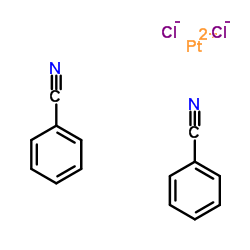
14873-63-3 |
| Literature: Canadian Journal of Chemistry, , vol. 74, # 2 p. 144 - 152 |
|
~60% 
14873-63-3 
14873-63-3 |
| Literature: Journal of the Chemical Society, Dalton Transactions: Inorganic Chemistry (1972-1999), , p. 947 - 952 |
|
~60% 
14873-63-3 
14873-63-3 |
| Literature: Inorganica Chimica Acta, , vol. 201, p. 15 - 22 |
| Precursor 2 | |
|---|---|
| DownStream 4 | |


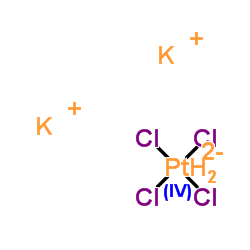
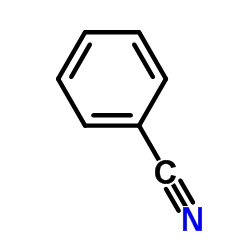
![Platinum,dichloro[1,1'-[1,2-ethanediylbis(thio)]bis[benzene]-S,S']-, (SP-4-2)- (9CI) structure](https://image.chemsrc.com/caspic/416/22455-18-1.png)

